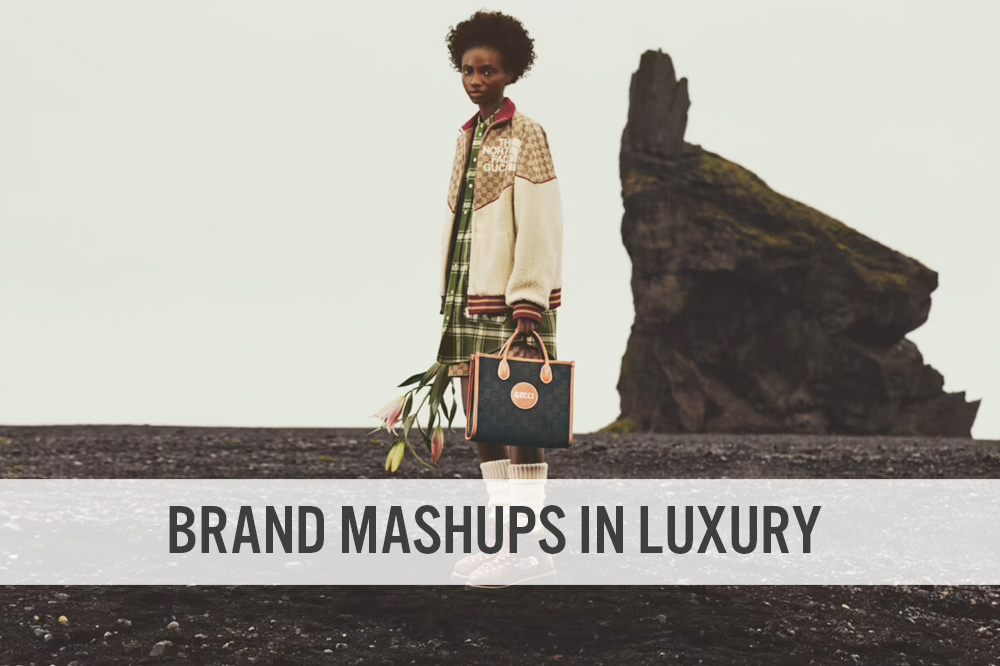
DIpil Das
Introduction
What’s the Story? Through 2020 and 2021, we saw numerous luxury brands enter partnerships to capture the attention of consumers through unique products, creative marketing and limited-time merchandise. With the ongoing hype around the metaverse (a digital reality that can include elements from virtual and augmented reality), several luxury brands are collaborating with unlikely partners to participate in the trend. In this report, we discuss the key benefits of collaboration and examine recent major luxury brand mashups. Why It Matters Just as with other sectors, luxury stores were closed for a good part of 2020 due to the Covid-19 pandemic, and a few still remain under restrictions in some parts of the world. Opportunities for shoppers to meet other luxury consumers and discover what is new in the market have been limited amid the global disruption, due to bans on travel in particular. With the threat of the Omicron variant, chances for international travel still hang in the balance, causing uncertainty for the global luxury market. In this challenging environment, it is critical that luxury brands and retailers make efforts to engage with consumers, tap new markets, and boost brand exposure and value—to recover lost sales and thrive in 2022 and beyond. One way to do this is through establishing brand partnerships, which enable brands to offer unique products and drive shopper excitement.Brand Mashups in Luxury: Coresight Research Analysis
Three Benefits of Collaboration 1. Drive Consumer Engagement Brand partnerships produce unique and often limited-edition products that help brands generate and drive consumer interest. Brands can employ nostalgia marketing to appeal to digital-first millennial and Gen Z consumers: Drawing on popular culture from a past era, brands can create opportunities for lively, ongoing conversation between fans who are potential luxury shoppers. Collaborations that provoke nostalgia have typically performed well in terms of consumer engagement. A machine-learning algorithm by Launchmetrics, a digital marketing platform, analyzes the impact of a brand’s marketing and public relations (PR) efforts across channels and markets, with the resulting “media impact value” (MIV) being a monetary value that provides a measure of the return on investment (ROI) of a marketing campaign (taking into account factors such as the reach and quality of the content). This enables brands to compare results across various voices, channels, media types, time periods, products and regions, for example, to benchmark performance. In Figure 1, we present the MIV metrics for four brand partnerships involving luxury companies that leveraged nostalgia—launching collaborations with cartoon characters. The most successful of these is Gucci’s partnership with global conglomerate Disney. The companies launched a Gucci x Mickey Mouse collection for Chinese New Year in 2020, which generated a huge $37 million in MIV. Gucci also collaborated with Japanese manga animation brand Doraemon in 2021. Launchmetrics’ Chief Marketing Officer, Elijah Whaley, told Vogue Business in January 2021, that a major portion of the MIV came from China for both of these collaborations. Whaley also noted that brands need to be nuanced in their approach to choosing partners: Apparel brand Uniqlo also has a collaboration with Doraemon, so exclusivity would have been somewhat diluted for Gucci’s collaboration.Figure 1. MIV of Selected Luxury Brands’ Collaborations with Cartoon Characters in 2020–2021 [caption id="attachment_140414" align="aligncenter" width="700"]
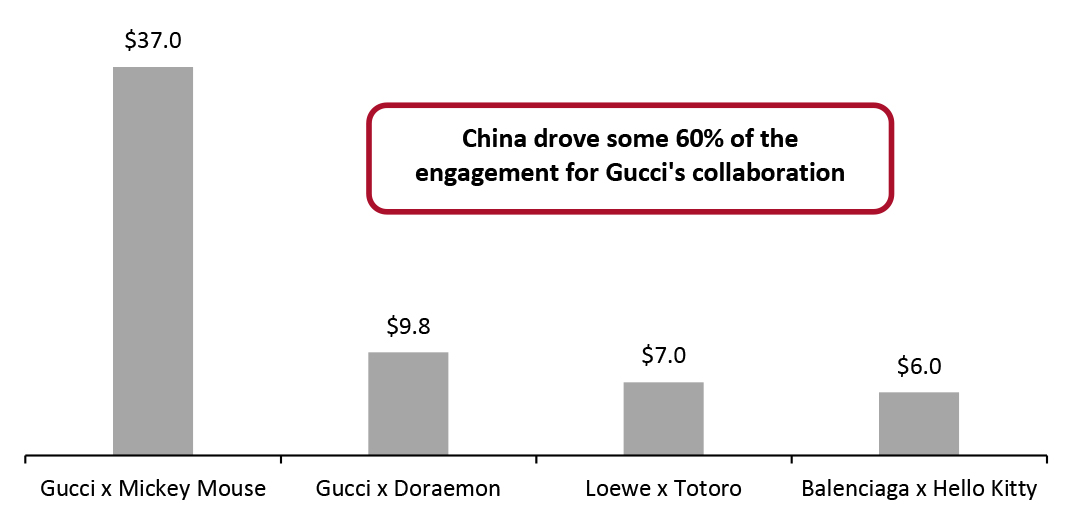 MIVs for Loewe x Totoro and Balenciaga x Hello Kitty are approximate
MIVs for Loewe x Totoro and Balenciaga x Hello Kitty are approximate Source: Launchmetrics [/caption] 2. Tap New Markets and Reflect Local Culture or Subcultures Collaborations with players outside the luxury sector may be brand dilutive if done improperly—but if done well, such partnerships can provide instant access to new markets. Gucci’s collaboration with The North Face, launched in December 2020, helped it amass huge consumer interest and build its presence outside the brand’s main markets of the US and Europe. When Gucci announced a raffle for early access to the collection, some 1.7 million people signed up, leading the brand’s website to crash for a brief time. Gucci had celebrities from around the world promote the Gucci x The North Face collection, including American actor and musician Jared Leto, Thai actor and model Davikah Hoorne and Russian model Mariya Minogarova, leading to greater brand awareness outside the typical markets where Gucci is popular. According to Launchmetrics, the collaboration generated $15.3 million in MIV between September 23, 2020, and January 13, 2021. [caption id="attachment_140415" align="aligncenter" width="700"]
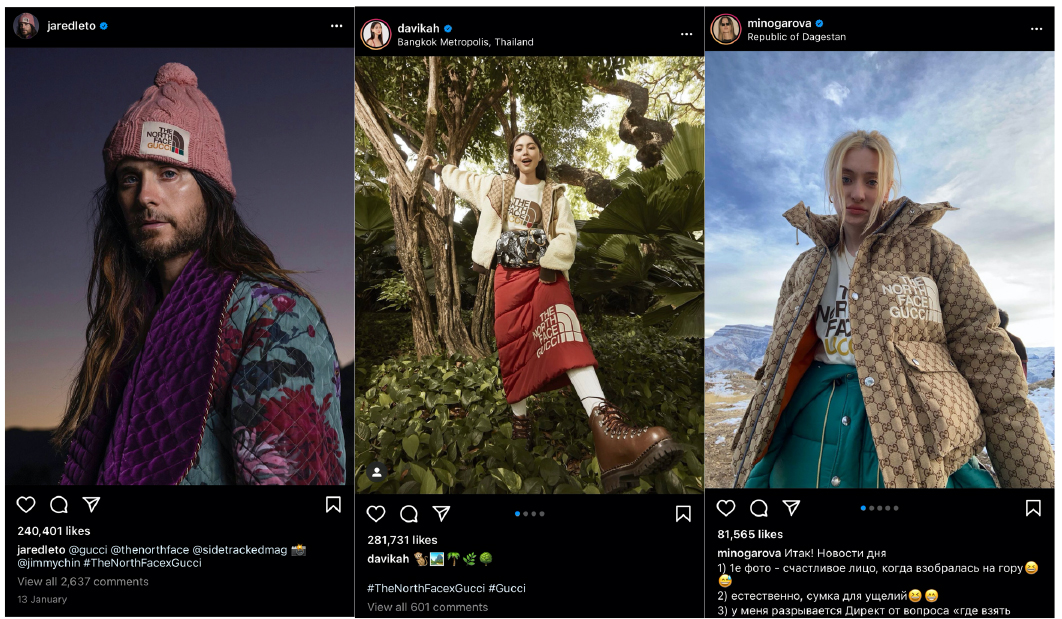 Celebrities Jared Leto, Davikah Hoorne and Mariya Minogarova showcase pieces from the Gucci x The North Face collection
Celebrities Jared Leto, Davikah Hoorne and Mariya Minogarova showcase pieces from the Gucci x The North Face collection Source: Instagram [/caption] Luxury brands can also benefit from trends seen in other retail segments that are not typically seen in luxury. For example, Louis Vuitton collaborated with high-end streetwear brand Supreme in 2017 to tap into the streetwear trend popular among young consumers. Cult streetwear brand Supreme is known to drop new releases surrounded by extensive fanfare. This collaboration was so popular that it sold out within two weeks of launch and Louis Vuitton had to close the pop-up stores dedicated for this collection alone. 3. Elevate Brand Value Brand collaborations tend to offer limited-time products—amplifying the sense of urgency for shoppers to purchase the product, thus driving demand and so increasing brand value. If products are sold out at brands’ own stores, customers may only be able to get their hands on those products through online resale sites, which often see huge price inflation due to the mismatch of product availability with high demand. Dior’s collaboration with NIKE in 2020 saw the launch of 8,000 Air Dior limited-edition sneakers priced at around $2,000 (Air Jordans from NIKE typically cost $100–$200). Resellers have priced these products much higher: The high-top sneakers cost around $8,000 on The RealReal and over $10,000 on Farfetch, while the low-top version costs between $7,700 and $21,630 on Farfetch, as of December 1, 2021. [caption id="attachment_140416" align="aligncenter" width="700"]
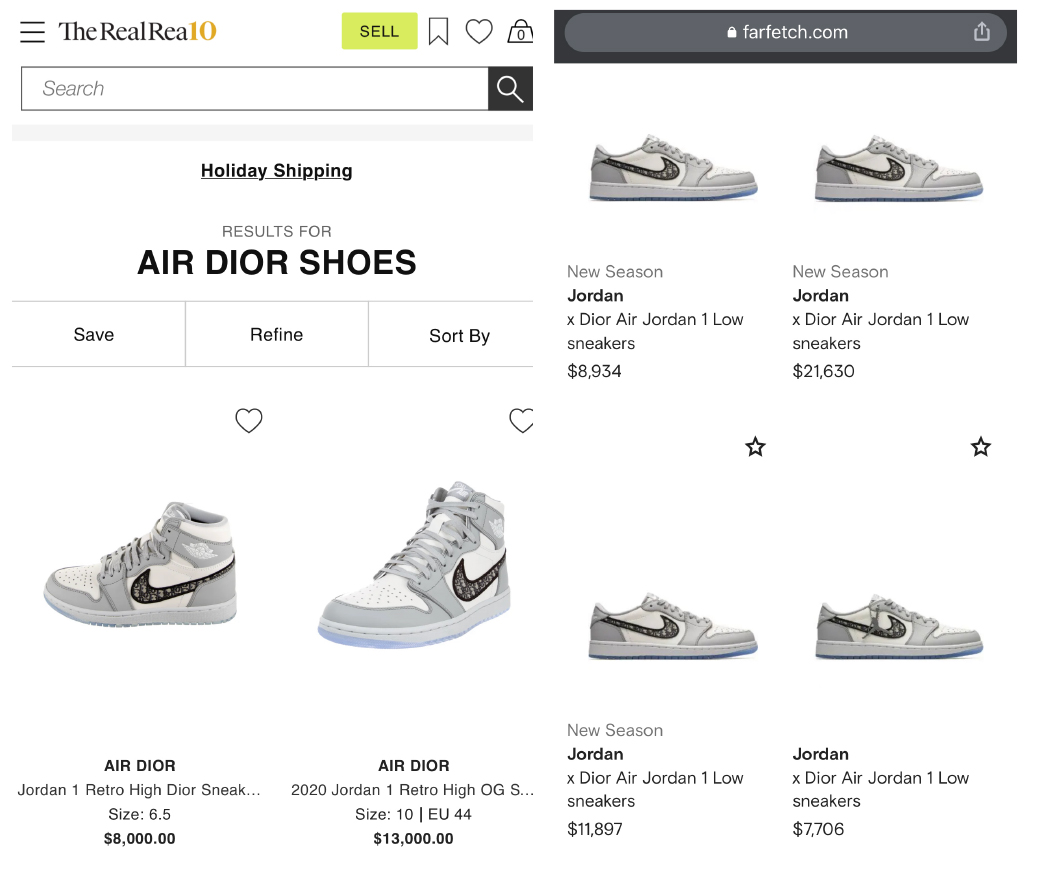 Previously owned Air Dior sneakers for sale on The RealReal (left) and Farfetch (right)
Previously owned Air Dior sneakers for sale on The RealReal (left) and Farfetch (right) Source: Farfetch/The RealReal [/caption] One of the most sought-after collaborations in recent times is the Nike x Off-White line developed by the sports giant and the late Virgil Abloh, Founder of luxury label Off-White and the erstwhile artistic director of Louis Vuitton. After Abloh’s passing on November 28, 2021, the prices of the sneakers from the Off-White x Nike Air Jordan 1 collection, originally launched in 2018, shot up to over $5,000 on resale site StockX (previously, all shoes in the Off-White and NIKE collaboration collections sold for around $1,000). Shoes from Abloh’s more recent collaboration with NIKE—the Off-White x Air Jordan 2 collection, which was released on November 12, 2021—have also been selling at higher prices on resale sites since the designer’s passing. In-House Collaborations In-house collaborations—between two brands belonging to the same luxury parent company—present several advantages:
- Both houses can leverage sourcing and distribution synergies.
- Fees and costs associated with licensing remain within the parent company.
- There could be a crossover of audiences from both brands.
- They provide a testing ground for both brands to learn from each other, and they can apply these learnings to future partnerships.
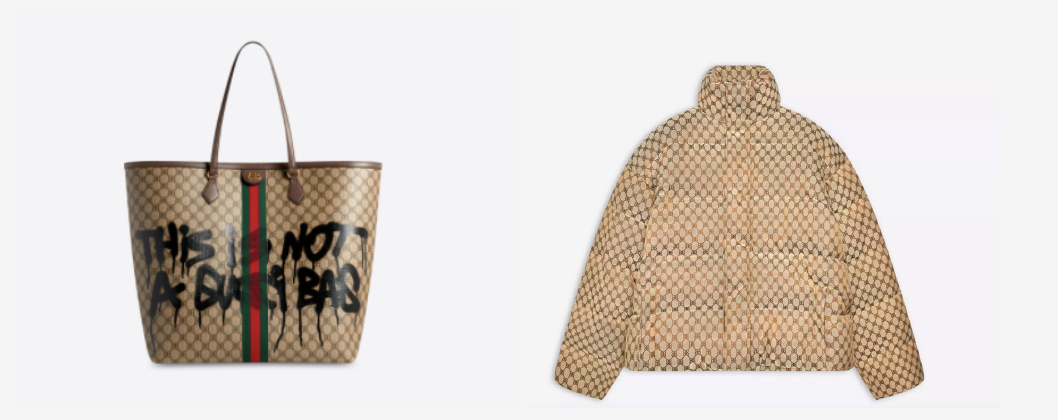 A bag and puffer jacket from Gucci’s and Balenciaga’s The Hacker Project
A bag and puffer jacket from Gucci’s and Balenciaga’s The Hacker Project Source: Balenciaga [/caption] Kering has many events and promotions planned to commemorate Gucci’s 100th anniversary this year, and this is one of them—a move that could help recover some lost sales from amid the Covid-19 pandemic: In 2020, revenues for Gucci dropped by nearly 22.7%, and the Kering business segment to which Balenciaga belongs saw a revenue decline of 10.1%. While both reporting segments experienced strong revenue recovery in the first nine months of 2021, the collaboration could provide a sales boost for both brands. LVMH: Fendi and Rimowa LVMH’s luggage brand Rimowa and fashion and leather-goods brand Fendi unveiled their third collaboration in August 2021 with pre-orders for the new collection of Rimowa suitcases with Fendi branding, followed by a general launch in September 2021. The brands had previously collaborated in 2017 and 2018, but the Louis Vuitton and Supreme collection outshone the Fendi and Rimowa collaboration. This time, the collaboration seems to have had a longer lifespan, as Fendi has included a piece from the collaboration in its Fendi 2022 Spring Festival Collection in honor of the Chinese Spring Festival and Lunar New Year. Multibrand Collaborations: Balenciaga, Gap and Yeezy In January 2022, Balenciaga, streetwear label Yeezy, apparel brand Gap announced their “YEEZY GAP Engineered by Balenciaga” collaboration. The collection features jackets and hoodies and is available globally alongside the existing YEEZY GAP collection. This hybrid collaboration draws on consumers from three different segments of the market—luxury, premium and mid-market—and attempts to blur the lines distinguishing these segments. By cutting across these segments, Balenciaga and Yeezy have greater chances of acquiring aspiring luxury and premium consumers or those that would like to experiment with luxury but may have felt the price-points were too high. Luxury Collaborations in the Metaverse Luxury brands have been some of the frontrunners in the retail metaverse. Collaborations in the metaverse afford brands a greater opportunity to experiment with little investment compared to dropping physical product lines at a greater risk: Digital products can be “deleted” while physical products tend to have a more permanent presence. Physical products also take longer to create and are more resource-intensive than digital products.
- The metaverse was the biggest buzzword at the NRF 2022: Retail’s Big Show. Read key insights from the event into this topic and more in our separate report.
 A Balmain Barbie NFT
A Balmain Barbie NFT Source: MintNFT.com [/caption] Gucci and Superplastic: Gucci has teamed up with Superplastic, a company that makes limited-edition vinyl toys and digital collectibles, to launch a collection of NFTs and ceramic sculptures called Supergucci. The 250-NFT collection is launching in three portions, with the first 10 having been released on February 1, 2022. It will combine Gucci motifs with popular Superplastic digital characters Janky and Guggimon, and the initial collection of NFTs will come with exclusive ceramic sculptures crafted by Gucci’s Italian ceramicists. Prada and Adidas: After the two brands announced a collaboration featuring physical products made with Prada’s recyclable Re-Nylon fabric in early January 2022, they launched a project called “Adidas for Prada re-source” in the metaverse on January 20. The brands are calling on 3,000 artists to create a piece of digital art that will form one single NFT. The final NFT will later be auctioned on SuperRare, a marketplace for NFT artwork. Collaborating with Adidas for physical products as well as in the metaverse will position Prada for greater visibility among younger, digitally inclined consumers.
Figure 2. Key Metrics of Selected Collaborations in Luxury [wpdatatable id=1662 table_view=regular]
Source: BragMyBag/company websites/eBay/Mattel/The RealReal/Vestiaire Collective/Coresight Research
What We Think
Louis Vuitton’s collaboration with Supreme may have been the most successful among a number of collaborations, measured by the collection’s huge change in prices from sale to resale. However, we think that Gucci is establishing itself as a leader of brand mashups. Gucci’s choice of partners connects the brand with popular culture and its high frequency of announcements as well as its digital engagement strategies ensure that the brand remains relevant among young consumers. We may witness more collaborations from Gucci, given the success of its earlier collaborations and its drive for product innovation. Implications for Brands/Retailers- Non-luxury brands can look to collaborate with luxury brands and benefit from their visibility and brand perception to help kickstart sales in a sluggish consumer environment.
- Collaborations create learning opportunities for brands to learn from strategies of those that they partner with and draw insights from markets they do not otherwise have access to.
- Collaborations harness innovation and creativity and push brands to create truly unique products, synergize their resources and give them an edge over their competitors.